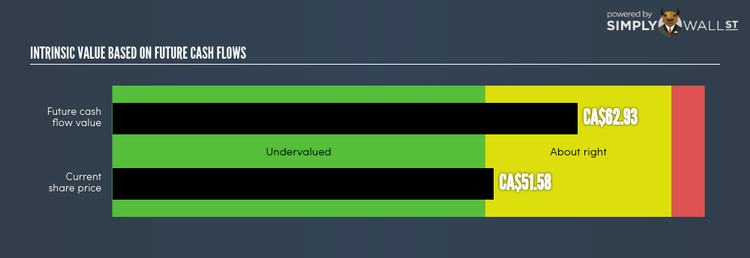Is There An Opportunity With Sun Life Financial Inc’s (TSE:SLF) Mispricing?

Pricing SLF, a financial stock, can be difficult since these insurance businesses have cash flows that are affected by regulations that are not imposed upon other sectors. Industry-specific factors, such as gross written premiums are crucial in understanding how insurance companies make money. Emphasizing line items such as book values, in addition to the return and cost of equity, can be useful for estimating SLF’s valuation. Below I’ll take you through how to value SLF in a reasonably useful and easy way. View our latest analysis for Sun Life Financial
What Is The Excess Return Model?
Financial firms differ to other sector firms primarily because of the kind of regulation they face and their asset composition. Canada’s financial regulatory environment is relatively strict. In addition to this, insurance companies usually do not possess significant portions of tangible assets on their balance sheet. This means the Excess Returns model is best suited for calculating the intrinsic value of SLF rather than the traditional discounted cash flow model, which has more emphasis on things like capital expenditure and depreciation.
Deriving SLF’s Intrinsic Value
The central assumption for Excess Returns is that equity value is how much the firm can earn, over and above its cost of equity, given the level of equity it has in the company at the moment. The returns above the cost of equity is known as excess returns:
Excess Return Per Share = (Stable Return On Equity – Cost Of Equity) (Book Value Of Equity Per Share)
= (13.35% – 8.76%) * CA$37.2 = CA$1.71
We use this value to calculate the terminal value of the company, which is how much we expect the company to continue to earn every year, forever. This is a common component of discounted cash flow models:
Terminal Value Per Share = Excess Return Per Share / (Cost of Equity – Expected Growth Rate)
= CA$1.71 / (8.76% – 2.13%) = CA$25.73
These factors are combined to calculate the true value of SLF’s stock:
Value Per Share = Book Value of Equity Per Share + Terminal Value Per Share
= CA$37.2 + CA$25.73 = CA$62.93
Relative to the present share price of CA$51.58, SLF is currently fairly priced by the market. This means SLF isn’t an attractive buy right now. Valuation is only one side of the coin when you’re looking to invest, or sell, SLF. There are other important factors to keep in mind when assessing whether SLF is the right investment in your portfolio.
Next Steps:
For insurance companies, there are three key aspects you should look at:
Financial health: Does it have a healthy balance sheet? Take a look at our free bank analysis with six simple checks on things like leverage and risk.
Future earnings: What does the market think of SLF going forward? Our analyst growth expectation chart helps visualize SLF’s growth potential over the upcoming years.
Dividends: Most people buy financial stocks for their healthy and stable dividends. Check out whether SLF is a dividend Rockstar with our historical and future dividend analysis.
For more details and sources, take a look at our full calculation on SLF here.
To help readers see pass the short term volatility of the financial market, we aim to bring you a long-term focused research analysis purely driven by fundamental data. Note that our analysis does not factor in the latest price sensitive company announcements.
The author is an independent contributor and at the time of publication had no position in the stocks mentioned.

